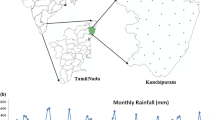Abstract
Contaminations of groundwater by heavy metals due to agricultural activities are growing recently. The objective of this study was to evaluate and map regional patterns of heavy metals (Cd, Zn and Cu) in groundwater on a plain with high agricultural activities. The study was conducted to investigate the concentration of heavy metals and distribution in groundwater in regions of Shush Danial and Andimeshk aquifers in the southern part of Iran. Presently, groundwater is the only appropriate and widely used source of drinking water for rural and urban communities in this region. The region covers an area of 1,100 km2 between the Dez and Karkhe rivers, which lead to the Persian Gulf. For this study, the region was divided into four sub-regions A, B, C and D. Additionally, 168 groundwater samples were collected from 42 water wells during the earlier months of 2004. The flame atomic absorption spectrometry (AAS-Flame) was used to measure the concentration of heavy metals in water samples and the Surfer software was used for determination of the contour map of metal distribution. The results demonstrated that in all of the samples, Cd and Zn concentrations were below the EPA MCLG and EPA secondary standard, respectively. However, the Cu contents of 4.8 % of all samples were higher than EPA MCL. It is also indicated that the concentrations of metals were more pronounced at the southern part of the studied region than at the others. The analysis of fertilizers applied for agricultural activities at this region also indicated that a great majority of the above-mentioned heavy metals were discharged into the environment. Absence of confining layers, proximity to land surface, excess agricultural activities in the southern part and groundwater flow direction that is generally from the north to the southern parts in this area make the southern region of the Shush plain especially vulnerable to pollution by heavy metals than by other contaminants.










Similar content being viewed by others
References
APHA (1998) Standard methods for examination of water and wastewater, 20th Edn. Administrative Public Health Administration, AWWA, WPCF, Washington DC
AOKC (2003) Census of agriculture: Khozestan County agricultural data. Agriculture Organization of Khozestan County
Alloway BJ, Jackson AP (1991) The behavior of heavy metals in sewage amended soils. Sci Total Environ 100:151–176
Brantley AS, Townsend TG (1999) Leaching of pollutants from reclaimed asphalt pavement. Environ Eng Sci 16:105–116
Eugenia GG, Vicente A, Rafael B (1996) Heavy metals incidence in the application of inorganic fertilizers and pesticides to rice farming soils. Environ Pollut 92:19–25
Fry A (2005) Water facts and trends, World Business Council for Sustainable Development: 16
Hani H (1990) The analysis of inorganic and organic pollutants in soil with special to their bioavailability. Int J Environ Anal Chem 39:197–308
Mahvi AH, Nouri J, Nabizadeh R, Babaei AA (2005) Agricultural activities impact on groundwater nitrate pollution. Int J Environ Sci Tech 2(1):41–47
Muchuweti M, Birkett JW, Chinyanga E, Zvauya R (2006) Heavy metal content of wastewater and sewage sludge in Zimbwe: implications for human health. Agric Ecosyst Environ 112(1):41–48
Nouri J, Mahvi AH, Babaei AA (2006) Regional pattern distribution of groundwater fluoride in the Shush aquifer of Khuzestan County, Iran. Fluoride 39(4):321–325
Picker CH, Hawkins LS, Pehrson JE, O’Connell NV (1992) Irrigation practices, herbicide use and groundwater contamination in citrus production: a case study in California. Agric Ecosyst Environ 41(1):1–17
Pogotto C, Remy N, Legret M, Le Cloirec P (2001) Heavy metal pollution of road dust and roadside soil near a major rural highway. Environ Tech 22:307–319
Rangsivek R, Jekel MR (2005) Removal of dissolved metals by Zero-Valent Iron (ZVI). Water Res 39:4153–4163
Rattan RK, Datta SP, Chhonkar PK, Suribabu K, Singh AK (2005) Long-term impact of irrigation with sewage effluent on heavy metal content in solid, crops and groundwater: a case study. Agric Ecosyst Environ 109(3–4):310–322
Romic M, Romic D (2003) Heavy metal distribution in agricultural topsoil in urban area. Environ Geol 43(7):795–805
Santos A, Alonso E, Callejon M, Jimenez JC (2002) Distribution of Zn, Cd, Pb and Cu metals in groundwater of the Guadiamar River Basin. Water, Air, Soil Poll J 134(1–4):273–283
Tanji K, Valoppi L (1989) Groundwater contamination by trace elements. Agric Ecosyst Environ 26(3–4):229–274
WHO (1997) Guidelines for drinking water quality. World Health Organization, 2nd Edn., vol 1: Recommendations
Acknowledgment
The authors would like to thank Prof. B. Larijani, Chancellor of Tehran University of Medical Sciences, for his financial support for this research.
Author information
Authors and Affiliations
Corresponding author
Rights and permissions
About this article
Cite this article
Nouri, J., Mahvi, A.H., Jahed, G.R. et al. Regional distribution pattern of groundwater heavy metals resulting from agricultural activities. Environ Geol 55, 1337–1343 (2008). https://doi.org/10.1007/s00254-007-1081-3
Received:
Accepted:
Published:
Issue Date:
DOI: https://doi.org/10.1007/s00254-007-1081-3




